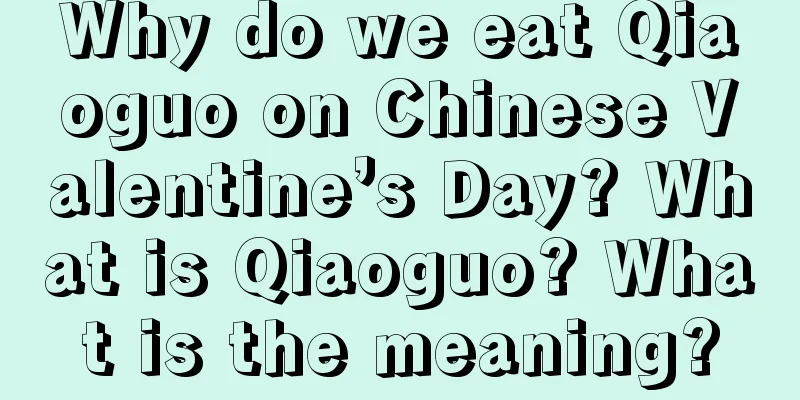Why do we eat Qiaoguo on Chinese Valentine’s Day? What is Qiaoguo? What is the meaning?

Chinese Valentine's Day. The Chinese Valentine's Day is also known as the Qiqiao Festival. In recent years, due to the influence of foreign cultures, foreign festivals have gradually become popular in China, and with media hype, the Chinese Valentine's Day has also taken on the cultural meaning of "Chinese Valentine's Day" in contemporary times. Generally, traditional festivals are inseparable from food, and the Chinese Valentine’s Day also has specific food. So do you know what the traditional foods of the Chinese Valentine’s Day are? July is named the Melon Month because fruits and melons are fragrant. What are the good days in July of the lunar calendar in 2020? Let’s take a look at the special topic of July 2020 on Shuimoxiansheng.com.Why do we eat Qiaoguo on Chinese Valentine’s Day?Legend source:1. A long time ago, there was a little girl named Xiaoqiao. She sympathized with the Cowherd and the Weaver Girl. Every year on the Chinese Valentine's Day, she would make an exquisite pastry and named it - Qiaoguo. Because "qiao" (qiao) and "qiao" (qiao) are homophones, people believe that eating the qiao fruit can make them more clever and can also act like a magpie to help the Cowherd and the Weaver Girl meet in the sky. This incident moved the Emperor of Heaven, so he blessed the girl and helped her find a happy marriage, so later on the Qixi Festival was also called Valentine's Day. 2. On the Chinese Valentine's Day, cakes shaped like fingers and tongues are made, which are called "Qiaoshi". Women and children string the "Qiaoshi" with colorful threads and throw them over the back of the roof, hoping that magpies will take them to build a bridge so that the Cowherd and the Weaver Girl can meet across the Milky Way at night. 3. Qiaoguo is the tears shed by the seven fairies. If you put it on babies, girls will become more clever and more beautiful. What is Qiaoguo? What is the meaning?The main ingredients of Qiaoguo are oil, flour, sugar and honey. Qiaoguo for the Qixi Festival has been sold as early as the Song Dynasty. There are many varieties and styles, but the general method remains the same: mix the syrup made from melted sugar with flour and sesame seeds, spread it on the table and roll it thin, cut it into rectangles with a knife, fold it into spindle-shaped Qiaoguo embryos, and then fry it in oil until golden brown. Doesn't it look similar to the chocolate on February 14th abroad?In some places, it is popular to string and dry the glutinous rice cakes. The glutinous rice cakes are strung together and tied to small wooden sticks or straw, and then decorated with colorful tassels. They are then hung on the wall or around children's necks as decorations or snacks. Some families hang it as a decoration for a year, and then eat the old ones when new ones are made the next year. Meaning: praying for oneself or a friend to be clever <br /> In addition, the fruits and vegetables used when begging for cleverness can also be varied. The fruits may be carved into exotic flowers and birds, or patterns may be embossed on the surface of the melon skin, which is called "flower melon". Qiaoguo and Huagua are the most common foods for the Chinese Valentine's Day. However, different dynasties in history had different food customs. For example, in the Wei Dynasty, it was popular to set up soup noodles on July 7th. The festival foods in the Tang Dynasty included chopped cakes on July 7th, and July 7th was designated as the Book Drying Festival. All officials below the three provinces and six ministries were given a certain amount of gold to prepare for a banquet, which was called the "Book Drying Party." Nowadays, in Hangzhou, Ningbo, Wenzhou and other places in Zhejiang Province, people still make various small items with flour on the Chinese Valentine's Day, fry them in oil, and call them "Qiaoguo". After the Qiaoguo is made, it is displayed on a table in the courtyard at night, with Qiaoguo, lotus pods, white jellyfish, red water chestnuts, etc. Family members and relatives sit around it, appreciating the vast night sky while tasting various Qiaoguo and other foods, everyone praying that they or their relatives and friends will become more dexterous. Other traditional foods for Qixi Festival include: Qiaoya noodles <br /> In addition to eating Qiaoguo, in some places, Qixi Festival lasts for two days. Qiaoguo is baked on the sixth day of the seventh month, and Qiaoya noodles are eaten on the seventh day of the seventh month. The bean sprouts used to make Qiao Ya noodles must be grown seven days in advance. Choose a small bowl of green beans that are not worm-eaten, wash them, spread them flat on a plate, cover them with wet gauze to block out the sunlight, place them on the head of the kang, and spray them with water several times a day to keep them moist. After seven days, when the bean sprouts grow to two or three centimeters long, you can make hand-rolled noodles. Boil them in a pot and rinse them with cold water. Stir-fry the scallions and ginger and stir-fry the diced meat. When stir-frying mung bean sprouts alone, use high heat and add a little vinegar. Put the noodles into a bowl, add diced meat and bean sprouts, and you can enjoy the delicious bean sprout noodles. |
Recommend
Which zodiac sign is in conflict with the 16th day of the 10th lunar month in 2019? Is it suitable for worshiping ancestors?
The wind in the tenth month of the lunar calendar ...
Is the fifth day of the tenth lunar month in the Gengzi Year of 2020 a good day to pick up a car?
Every day has good and bad, auspicious and inausp...
Is it good to have a baby during the period from Cold Dew to Frost Descent in 2020? Baby fate analysis
The fate of a baby born at different times is diff...
Is the Army Day on August 1, 2019 an auspicious day for offering sacrifices to graves?
Introduction: Generally, an auspicious day should ...
What are the suitable days for seeking offspring in August of the lunar calendar in 2019?
The eighth month of the lunar calendar is the eigh...
Folk Feng Shui story: An introduction to how Lu Meng defeated Guan Yu!
Lu Meng and Guan Yu are both more famous figures i...
Lunar November 2018: Auspicious days for moving
The eleventh month of the lunar calendar, also kno...
How many boxes of mooncakes should be given as gifts for the Mid-Autumn Festival in 2019? Who should not watch the moon during the Mid-Autumn Festival?
Introduction: Mid-Autumn Festival is an important ...
Is it not appropriate to get engaged on the Double Ninth Festival in September 2020? What is not popular to eat before and after the Double Ninth Festival?
Introduction: Generally, an auspicious day is requ...
Can I wear a skirt in the beginning of summer in 2021? What is the weather like during the Beginning of Summer?
Crickets are chirping in the fields, and melon vin...
Will it still get hotter after Grain Full? What are the climate characteristics of Xiaoman?
Grain Man is one of the 24 solar terms in my count...
Is the fifth day of the first lunar month in 2021 an auspicious day for a haircut?
It is not suitable to get a haircut at any time. Y...
The most correct way to place the fish tank at home
Introduction: Placing a fish tank at home is a com...
What is the lunar calendar for the Dragon Boat Festival on the fifth day of May 2019? Is it a good time to start renovations?
The earthly branch of the fifth month in the lunar...
2020 Lunar February 8th Lunar Calendar ...
In the second month of the lunar calendar, the sp...









